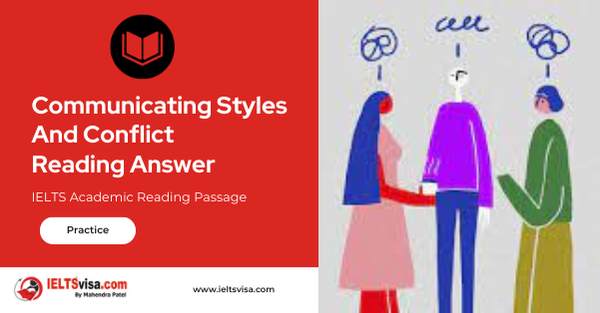Communicating Styles And Conflict Reading Answer
IELTS Academic Reading Passage
Knowing your communication style and having a mix of styles on your team can provide a positive force for resolving conflict.
A
As far back as Hippocrates’ time (460-370B.C.), people have tried to understand other people by characterizing them according to personality type or temperament.Hippocrates believed there were four different body fluids that influenced four basic types of temperament. His work was further developed 500 years later by Galen. These days there are any number of self-assessment tools that relate to the basic descriptions developed by Galen, although we no longer believe the source to be the types of body fluid that dominate our systems.
B
The values in self-assessments that help determine personality style. Learning styles, communication styles, conflict-handling styles, or other aspects of individuals is that they help depersonalize conflict in interpersonal relationships. The depersonalization occurs when you realize that others aren’t trying to be difficult, but they need different or more information than you do. They’re not intending to be rude: they are so focused on the task they forget about greeting people. They would like to work faster but not at the risk of damaging the relationships needed to get the job done. They understand there is a job to do. But it can only be done right with the appropriate information, which takes time to collect. When used appropriately, understanding communication styles can help resolve conflict on teams. Very rarely are conflicts true personality issues. Usually they are issues of style, information needs, or focus.
C
Hippocrates and later Galen determined there were four basic temperaments: sanguine, phlegmatic, melancholic and choleric. These descriptions were developed centuries ago and are still somewhat apt, although you could update the wording. In today’s world, they translate into the four fairly common communication styles described below:
D
The sanguine person would be the expressive or spirited style of communication. These people speak in pictures. They invest a lot of emotion and energy in their communication and often speak quickly. Putting their whole body into it. They are easily sidetracked onto a story that may or may not illustrate the point they are trying to make. Because of their enthusiasm, they are great team motivators. They are concerned about people and relationships. Their high levels of energy can come on strong at times and their focus is usually on the bigger picture, which means they sometimes miss the details or the proper order of things. These people find conflict or differences of opinion invigorating and love to engage in a spirited discussion. They love change and are constantly looking for new and exciting adventures.
E
Tile phlegmatic person – cool and persevering – translates into the technical or systematic communication style. This style of communication is focused on facts and technical details. Phlegmatic people have an orderly methodical way of approaching tasks, and their focus is very much on the task, not on the people, emotions, or concerns that the task may evoke. The focus is also more on the details necessary to accomplish a task. Sometimes the details overwhelm the big picture and focus needs to be brought back to the context of the task. People with this style think the facts should speak for themselves, and they are not as comfortable with conflict. They need time to adapt to change and need to understand both the logic of it and the steps involved.
F
Tile melancholic person who is soft hearted and oriented toward doing things for others translates into the considerate or sympathetic communication style. A person with this communication style is focused on people and relationships. They are good listeners and do things for other people-sometimes to the detriment of getting things done for themselves. They want to solicit everyone’s opinion and make sure everyone is comfortable with whatever is required to get the job done. At times this focus on others can distract from the task at hand. Because they are so concerned with the needs of others and smoothing over issues, they do not like conflict. They believe that change threatens the status quo and tends to make people feel uneasy, so people with this communication style, like phlegmatic people need time to consider the changes in order to adapt to them.
G
The choleric temperament translates into the bold or direct style of communication. People with this style are brief in their communication – the fewer words the better. They are big picture thinkers and love to be involved in many things at once. They are focused on tasks and outcomes and often forget that the people involved in carrying out the tasks have needs. They don’t do detail work easily and as a result can often underestimate how much time it takes to achieve the task. Because they are so direct, they often seem forceful and can be very intimidating to others. They usually would welcome someone challenging them. But most other styles are afraid to do so. They also thrive on change, the more the better.
H
A well-functioning team should have all of these communication styles for true effectiveness. All teams need to focus on the task, and they need to take care of relationships in order to achieve those tasks. They need the big picture perspective or the context of their work, and they need the details to be identified and taken care of for success. We all have aspects of each style within us. Some of us can easily move from one style to another and adapt our style to the needs of the situation at hand-whether the focus is on tasks or relationships. For others, a dominant style is very evident, and it is more challenging to see the situation from the perspective of another style. The work environment can influence communication styles either by the type of work that is required or by the predominance of one style reflected in that environment. Some people use one style at work and another at home.
The good news about communication styles is that we have the ability to develop flexibility in our styles. The greater the flexibility we have, the more skilled we usually are at handling possible and actual conflicts. Usually it has to be relevant to us to do so, either because we think it is important or because there are incentives in our environment to encourage it. The key is that we have to want to become flexible with our communication style. As Henry Ford said, “Whether you think you can or you can’t, you’re right!”
Questions 1-8
Reading Passage has eight sections A-H. Choose the correct heading for each section from the list of headings below.
Write the correct number i-x in boxes 1-8 on your answer sheet.
List of Headings
I. Summarising personality types
II. Combined styles for workplace
III. Physical explanation
IV. A lively person who encourages
V. Demanding and unsympathetic personality
VI. Lazy and careless personality
VII. The benefits of understanding communication styles
VIII. Cautious and caring
IX. Factual and analytical personality
X. Self-assessment determines one’s temperament
- Section A
- Section B
- Section C
- Section D
- Section E
- Section F
- Section G
- Section H
Questions 9-13
Do the following statements agree with the information given in Reading Passage?
In boxes 9-13 on your answer sheet, write
TRUE if the statement agrees with the information
FALSE if the statement contradicts the information
NOT GIVEN if there is no information on this
9. It is believed that sanguine people dislike variety.
10. Melancholic and phlegmatic people have similar characteristics.
11. Managers often select their best employees according to personality types.
12. It is possible to change one’s personality type.
13. Workplace environment can affect which communication style is most effective.
Question 14
Choose the correct letter A, B, C or D.
Write your answers in box 14 on your answer sheet.
14. The writer believes using self-assessment tools can
A. help to develop one’s personality.
B. help to understand colleagues’ behaviour.
C. improve one’s relationship with the employer.
D. directly resolve conflicts.

Solutions For:-Communicating Styles And Conflict Reading Answer
| 1. iii | 8. ii |
| 2. vii | 9. FALSE |
| 3. i | 10. TRUE |
| 4. iv | 11. NOT GIVEN |
| 5. ix | 12. TRUE |
| 6. viii | 13. TRUE |
| 7. v | 14. B |
Review and Practice
- Regularly practice with IELTS reading samples and time yourself to get used to the pressure of the exam.
- Review your mistakes to understand where you went wrong and how to avoid similar errors in the future.
Our Books
Master IELTS Speaking Part 1
IELTS Writing Task 1 Book
IELTS Writing Task 2 Book
Communicating Styles And Conflict Reading Answer Explanation
Comin Soon
Practice IELTS Other Modules
IELTS Listening
The IELTS Listening test assesses how well you can understand spoken English in various contexts. It lasts about 30 minutes and is divided into four sections with a total of 40 questions. The listening tasks become increasingly difficult as the test progresses.
IELTS Academic Reading
The IELTS Academic Reading section assesses your ability to understand and interpret a variety of texts in academic settings. It is designed to evaluate a range of reading skills, including skimming for gist, reading for main ideas, reading for detail, understanding inferences, and recognizing a writer's opinions and arguments.
IELTS Speaking
The IELTS Speaking test assesses your ability to communicate in English on everyday topics. It lasts 11-14 minutes and consists of three parts: introduction, cue card, and a discussion based on the cue card topic.
IELTS General Reading
IELTS General Reading tests your ability to understand and interpret various types of texts. Here are some key areas and types of content you can expect to encounter in the reading section, along with tips for effective preparation.
IELTS Academic Writing Task 1
In IELTS Academic Writing Task 1, you are presented with a visual representation of information, such as graphs, charts, tables, or diagrams, and you are required to summarize, compare, or explain the data in your own words.
IELTS General Writing Task 1
In IELTS General Writing Task 1, you are required to write a letter based on a given situation. The letter can be formal, semi-formal, or informal, depending on the prompt. Here’s a breakdown of the key components to include in your letter
IELTS Academic Writing Task 2
In IELTS Academic Writing Task 2, you are required to write an essay in response to a question or topic. Here’s a guide to help you understand the essential elements of this task
IELTS Exam Tips
To succeed in the IELTS exam, practice regularly, familiarize yourself with the test format, improve your vocabulary, develop time management skills, and take mock tests to build confidence.
Grammer for IELTS
Grammar is the foundation of effective communication in English. Understanding tense usage, subject-verb agreement, and sentence structure enhances clarity and coherence in writing and speaking.
Vocabulary for IELTS
Vocabulary plays a crucial role in the IELTS (International English Language Testing System) exam, especially in the Speaking and Writing sections. Here’s an overview of why vocabulary is important and how it impacts your performance
RECENT IELTS SAMPLES QUESTIONS AND ANSWERS
Walking with dinosaurs
Peter L. Falkingham and his colleagues at Manchester University are developing techniques that...
Money as the Unit of Amount Reading Answers
The most difficult aspect of money to understand is its function as a unit of account. In...
WEATHERING IN THE DESERT
In the deserts, as elsewhere, rocks at the earth's surface are changed by weathering, which...
Nature on Display in American Zoos
The first zoo in the United States opened in Philadelphia in 1874, followed by the Cincinnati...
Can We Prevent the Poles From Melting
Such is our dependence on fossil fuels, and such is the volume of carbon dioxide we have...
Air conditioning the earth reading answers
The circulation of air in the atmosphere is activated by convection, the transference of heat...













